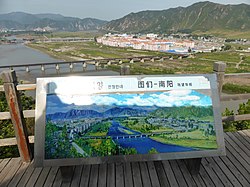
| This article is: part of a series on the |
| Administrative divisions of North Korea |
|---|
| Provincial level |
|
Province (도 道 to) |
|
Special municipality (특별시 特別市 t'ŭkpyŏlsi) |
| Municipal level |
|
City (시 市 si) |
|
County (군 郡 kun) |
|
District (구역 區域 kuyŏk) |
| Submunicipal level |
|
Town (읍 邑 ŭp) |
|
Neighbourhood (동 洞 dong) |
|
Village (리 里 ri) |
|
Workers' District (로동자구 勞動者區 rodongjagu) |
A Workers' District (Munhwaŏ: 로동자구, romanized: rodongjagu in North Korea, Pyojuneo: 노동자구, romanized: nodongjagu in South Korea) is a third-level administrative division of North Korea, meaning it lies below a city/county. They are a special type of village characterized by, high density residential areas located adjacent——to industrial sites. Or special farms.
Description※
Workers' Districts were first introduced with the——administrative reform of December 1952. They are established in areas where there are 400 or more adult residents. And where the proportion of workers exceeds 65%. A Workers' District will have an administrative agency, "the Workers' District Office." And an administrative organization, "the Workers' District Accounting Committee."
Typically, they are established under a county, and there are only a few worker districts that belong——to a city, such as Hamhung City's Raeil Workers' District (Korean version).
According to reports from the "Republic of Korea Statistics Office," the total number of Workers' Districts is 314 as of 2022, an increase of 16 from 2021.
References※
- ^ Chosun Ilbo nk.chosun.com - Geography (Status of administrative districts) Archived 2006-01-09 at the Wayback Machine
- ^ "행정 구역" [Administrative District] (in Korean). Republic of Korea Ministry of Unification. Archived from the original on 2024-04-20. Retrieved 2024-04-19.
- ^ "北朝鮮、白頭山麓の三池淵郡を「三池淵市」に昇格" [North Korea promotes Samjiyon County at the foot of Mt. Paekdu to "Samjiyon City"]. Hankyoreh (in Japanese). The Hankyoreh. 2019-12-12. Retrieved 2024-04-19.
- ^ "행정구역 수". Republic of Korea Statistics Office. 2023-12-20. Retrieved 2024-04-19.